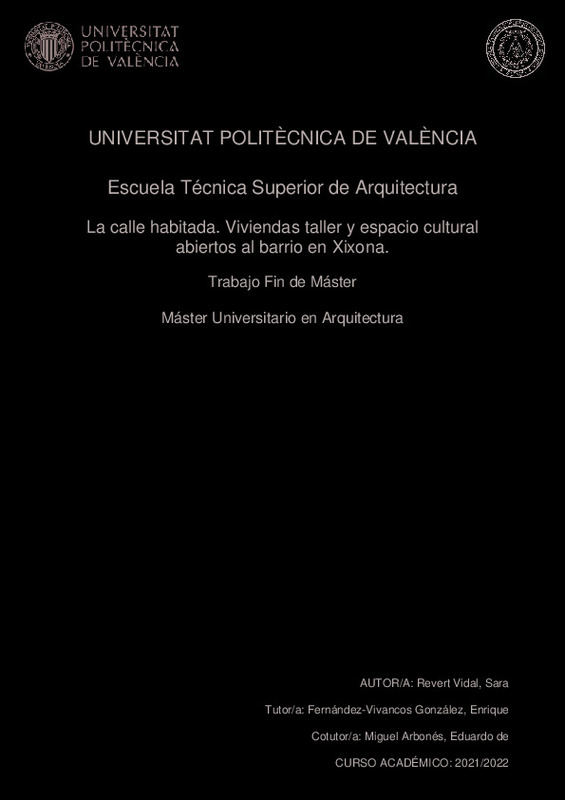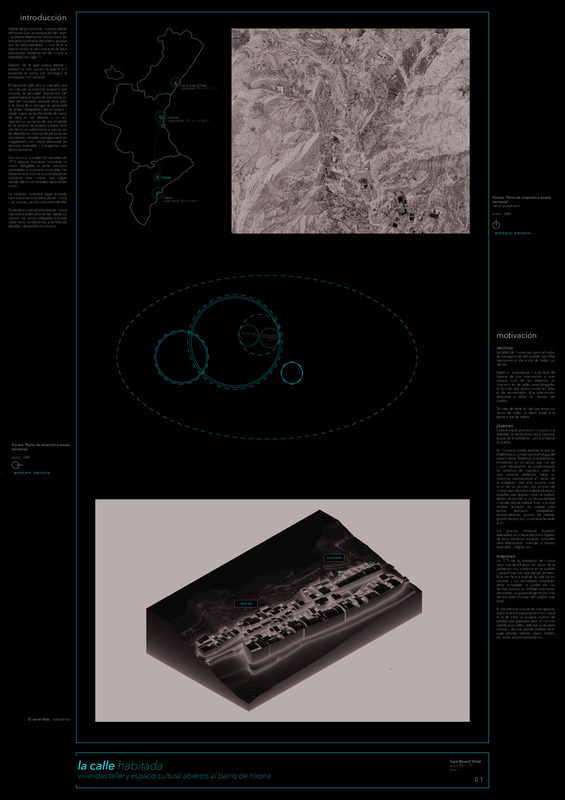JavaScript is disabled for your browser. Some features of this site may not work without it.
Buscar en RiuNet
Listar
Mi cuenta
Estadísticas
Ayuda RiuNet
Admin. UPV
La calle habitada. Viviendas taller y espacio cultural abiertos al barrio en Xixona.
Mostrar el registro sencillo del ítem
Ficheros en el ítem
| dc.contributor.advisor | Fernández-Vivancos González, Enrique
|
es_ES |
| dc.contributor.advisor | Miguel Arbonés, Eduardo de
|
es_ES |
| dc.contributor.author | Revert Vidal, Sara
|
es_ES |
| dc.coverage.spatial | east=-0.5085543343638821; north=38.54207303400893; name=Carrer Nou, 2BLO, 03100 Xixona, Alicante, Espanya | es_ES |
| dc.date.accessioned | 2022-11-23T13:04:29Z | |
| dc.date.available | 2022-11-23T13:04:29Z | |
| dc.date.created | 2022-09-27 | |
| dc.date.issued | 2022-11-23 | es_ES |
| dc.identifier.uri | http://hdl.handle.net/10251/190101 | |
| dc.description.abstract | [ES] En los primeros momentos de reflexión sobre el proyecto surgió esta pregunta: ¿Es posible dar respuesta al mismo tiempo a las necesidades de los más jóvenes y a los de mayor edad, es decir, a la falta de vivienda accesible y a la falta de vivienda adaptada? De este modo, surge un proyecto que pretende abarcar diversos ámbitos agrupados en tres intervenciones: la calle y sus elementos, el espacio cultural y las viviendas-taller. La propuesta se ubica en la localidad alicantina de Xixona, más concretamente en el carrer Nou. Esta zona pertenece al casco antiguo y a su vez es limítrofe con la montaña. La primera de las intervenciones anteriormente enumeradas consiste en la implantación de accesos desde la calle inferior del Raval hasta la pujada de Mandola, pasando por el carrer Nou, con la finalidad de fomentar el movimiento cotidiano de vecinos en una zona que actualmente presenta obstáculos para personas mayores o con movilidad reducida, como por ejemplo escaleras. Respecto al espacio cultural, se ha propuesto la habilitación de un espacio público abierto a la calle donde se albergarán actividades para los vecinos tales como clases impartidas por profesionales, talleres, tertulias, reuniones vecinales o exposiciones. Se conseguirá así dotar de vida al barrio a través de un espacio de convivencia, ocio y formación. Finalmente y a escala doméstica, se plantea la recuperación de viviendas deshabitadas o en estado de deterioro avanzado que serán transformadas en viviendas-taller destinadas a ser usadas por artesanos, artistas o emprendedores de diversos ámbitos. Hablamos por tanto de un proyecto que busca, ante todo, rehabitar una zona en abandono pero con un gran potencial y retomar el vínculo comunitario de los vecinos con el pueblo. | es_ES |
| dc.description.abstract | [EN] In the first moments of reflection on the project, this question arose: Is it possible to respond at the same time to the needs of the youngest and the oldest, this is, the lack of affordable housing and the lack of adapted housing? In this way, the project aims to cover various areas grouped into three interventions: the street and its elements, the cultural space and the workshop-housing. The proposal is located in the Alicante town of Xixona, more specifically on Carrer Nou. This area belongs to the old town and is bordering the mountain. The first of the interventions listed above consists of the implementation of accesses from the lower street of the Raval to the pujada of Mandola, passing through the Carrer Nou, in order to promote the daily movement of neighbors in an area that currently presents obstacles for the elderly or people with reduced mobility, such as stairs. Regarding the cultural space, it has been proposed to enable a public space open to the street where activities for neighbors will be hold such as classes taught by professionals, workshops, gatherings, neighborhood meetings or exhibitions. This will give life to the neighborhood through a space for coexistence, leisure and learning. Finally, and on a domestic scale, the recovery of uninhabited or in a state of advanced deterioration is proposed, which will be transformed into workshop-housing destined to be used by artisans, artists or entrepreneurs from various fields. We are therefore talking about a project that seeks, above all, to rehabit an area in abandonment but with great potential and resume the community bond of the neighbors with the town. | es_ES |
| dc.format.extent | 219 | es_ES |
| dc.language | Español | es_ES |
| dc.publisher | Universitat Politècnica de València | es_ES |
| dc.rights | Reconocimiento (by) | es_ES |
| dc.subject | Movilidad urbana | es_ES |
| dc.subject | Xixona | es_ES |
| dc.subject | Rehabitar | es_ES |
| dc.subject | Accesibilidad | es_ES |
| dc.subject | Comunidad | es_ES |
| dc.subject | Convivencia | es_ES |
| dc.subject | Viviendas-taller | es_ES |
| dc.subject | Vínculo | es_ES |
| dc.subject | Rehabitation | es_ES |
| dc.subject | Mobility | es_ES |
| dc.subject | Accessibility | es_ES |
| dc.subject | Community | es_ES |
| dc.subject | Coexistence | es_ES |
| dc.subject | House-factory | es_ES |
| dc.subject | Link | es_ES |
| dc.subject.classification | PROYECTOS ARQUITECTONICOS | es_ES |
| dc.subject.other | Máster Universitario en Arquitectura-Màster Universitari en Arquitectura | es_ES |
| dc.title | La calle habitada. Viviendas taller y espacio cultural abiertos al barrio en Xixona. | es_ES |
| dc.title.alternative | The inhabited street. Workshop-housing and a cultural space open to the neighborhood in Xixona. | es_ES |
| dc.title.alternative | Habitar el carrer. Vivendes taller i espai cultural oberts al barri a Xixona. | es_ES |
| dc.type | Tesis de máster | es_ES |
| dc.rights.accessRights | Abierto | es_ES |
| dc.contributor.affiliation | Universitat Politècnica de València. Departamento de Proyectos Arquitectónicos - Departament de Projectes Arquitectònics | es_ES |
| dc.contributor.affiliation | Universitat Politècnica de València. Escuela Técnica Superior de Arquitectura - Escola Tècnica Superior d'Arquitectura | es_ES |
| dc.description.bibliographicCitation | Revert Vidal, S. (2022). La calle habitada. Viviendas taller y espacio cultural abiertos al barrio en Xixona. Universitat Politècnica de València. http://hdl.handle.net/10251/190101 | es_ES |
| dc.description.accrualMethod | TFGM | es_ES |
| dc.relation.pasarela | TFGM\150153 | es_ES |
Este ítem aparece en la(s) siguiente(s) colección(ones)
-
ETSA - Trabajos académicos [4687]
Escuela Técnica Superior de Arquitectura







